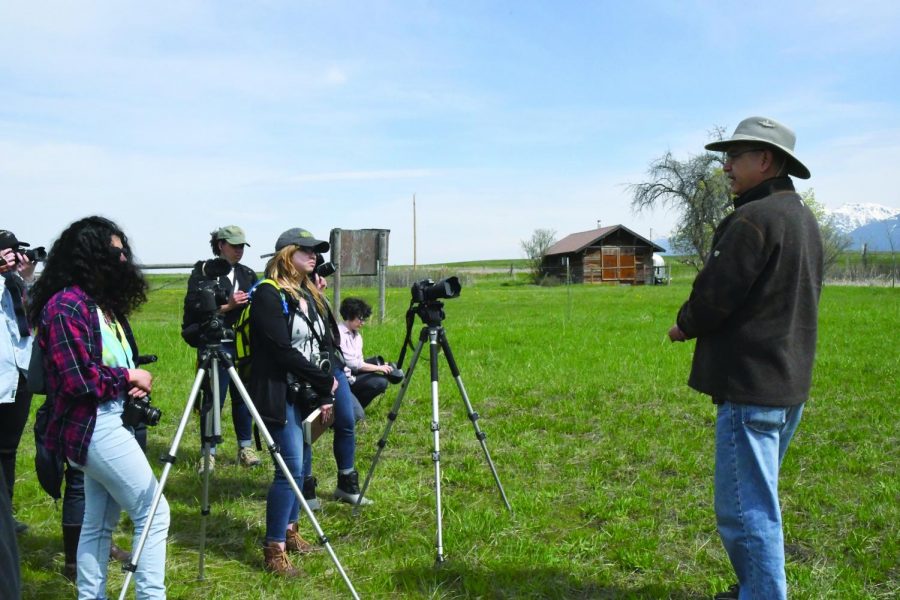Photography class films documentary in Montana
“Tailing History” centered around restoration of watershed
Photo by Gracey Evans
Students of the environmental photography class interview Kootani Councilman David Stiffarm.
August 28, 2018
When most students were winding down last semester after finals week, the specialized photography class was packing their bags for the western plains of the Montana wilds.
After nearly four months of solid planning, researching and photography skill development, 11 students embarked on a week-long expedition to produce a documentary surrounding the environmental issues impacting the Clark Fork River Basin area.
Derek Watson, senior graphic design major, was surprised at the sheer impact mining left on the area.
“You could see the footprint of the industrial past and how it didn’t detract from the natural beauty of the area,” Watson said. “Once you got up close and were given an interpretational view of what you were seeing, it was really surprising that the scale of industrialization there could leave such a footprint in an area with big beautiful mountains.”
Professor Chris Rolinson echoed a similar realization.
“Montana is a place you imagine to be so pristine and untouched and has fewer environmental problems than where you live, but in fact the opposite is true,” Rolinson said. “They have just as many issues with the environment there as we do here.”
The Clark Fork River Basin makes up one of the largest superfund sites in America. A lawsuit for the site started in the 80s when the first superfund law came about.
It was one of the first lawsuits of this nature in the country against Anaconda Copper Company. In turning ore to copper, excessive waste product resulted from the smelting process. For decades, it flushed pollutants out into the river, a time predating environmental laws.
Three superfund complexes in the area fought for funds to clean up the damage. As a result of the lawsuit, local nonprofits like the Clark Fork River Coalition now have access to billions of dollars for river cleanup.
The trip was funded by the Heinz Endowment and students spent a week in the state, driving hours at a time from interview to interview.
Graduate Assistant Rebecca Lessner said that the most valuable aspect of the trip was seeing the impact they had on locals for sharing their stories.
“Everyone out there is so involved because this is their home,” Lessner said. “Realizing how important this is to everyone else and how much it means to each person to have their work documented was emotional. These people have been restoring their home for 38 years and now the river is just getting to a level where a child can play in it.”
One man, Jim Flynn, grew up in Anaconda near the smelter. He shared that it was common knowledge to never go near the river. In small towns where pollution is the result of an industry that supports the livelihoods of so many families, recognizing change can be an emotional experience.
“At one point he started to tear up when we asked him to compare then and now,” Lessner said. “The copper mines kept them afloat while they were poisoning their own town without knowing it. Once the copper mining stopped and cleanup began, the town changed. You didn’t want to compare it because then it was booming and popular and now there is less business and commerce.”
Money from the lawsuit can only be used toward the cleanup. It’s a familiar story across the rustbelt of America, towns grappling toward a new purpose as the industry they depend on dwindles.
“It was a very powerful moment, I’m glad we got it on tape,” Lessner said.
Teamwork was an essential skill for the group to accomplish what they did in a short time.
“The students were excellent,” Rolinson said. “They showed up and were professional. They pretty much put the entire thing together. Each student was assigned a person to research and figure out what to ask them in the interview.”
In total, seven interviews were completed while they were on the trip. Biologists, lawsuit participants and even a local Kootenai tribe elder were interviewed.
Watson worked on developing the title graphics for the final product. His time in Montana reinforced some pre-existing beliefs.
“I’ve always have had a bent toward being conscientious about being a responsible consumer,” Watson said. “This gave me a historic view about what unabated industrialism and materialism can do.”
The documentary is currently in post-production editing, with a final length slated for around 30 minutes. The goal is to have the film finished and ready to pitch to public television and film festivals by January. A showing will also be held on campus next semester.
Rolinson said the students learned a lot about the complexity of media throughout the project.
“When you see it on a screen, it looks so comfortable and easy to watch and that’s no accident,” he said. “It’s hours of work and we spent probably a hundred hours in the car just getting from place to place – that’s sort of the ugly side of it. It required a lot of effort and planning.”
Many of the issues students saw in Montana can be seen right here in Pittsburgh.
“There’s definitely a linkage between some of the systemic problems there and what we are dealing with here,” Rolinson said. “I was hoping students would see that and come back here to Western Pennsylvania looking through a different frame, more cognisant of the environmental issues of where they stand.”

















